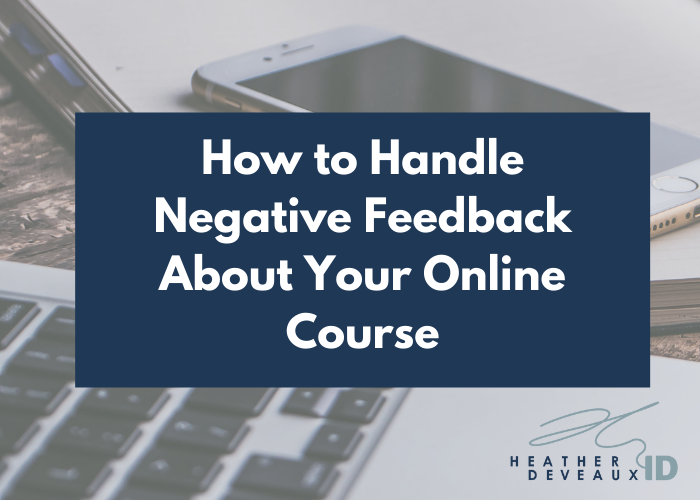How to Deal with Negative Feedback About Your Online Course
Want to know how to handle negative feedback about your online course like a champ? And set it up the right way so that you are confident in what you’re selling? Keep reading.
Let’s talk about when someone takes your online course and they have less-than-ideal feedback about it. There are a series of questions and steps you want to go through here if this happens to you. I’m going to walk you through some questions. They will help you see that negative feedback is not the end of the world. Then I’ll walk you through how to ensure your course is exactly what your customers want to buy.
Do You Value the Source of the Feedback?
Ask yourself this question: do you value the source of the negative feedback? Also ask, at what point in the course development phase did you receive the feedback? For example, beta testers will have a lot more to say than 3rd generation users.
Some course creators ask friends to review their courses. Unless those “friends” are your potential customers, their feedback is not very helpful. To me it would be like asking Adele which microphone she uses on stage in order to help you decide which microphone to buy for your home office. They’re totally different. You need to ask the right people the right questions.
You may ask someone for feedback directly. And some people may interpret this to mean “be ruthless.” You’ll want to provide direction on giving feedback. That’s why it’s important to have a system in place for collecting feedback and data from your customers. And it’s even more important if you are beta testing your course.
What Lens Are They Using to Evaluate Your Course?
You may be pretty upset when someone gives you negative feedback. Asking the right questions at the right time mean you don’t become overwhelmed with emotion.
Here’s an example: my client gave her course to a graphic designer to test out. Except the only feedback the customer gave her was about the design of the course. There was virtually no feedback about whether or not the customer learned something. This is a great example of how people take liberties with your content. The customer was only looking at the course through the lens of graphic design. And here’s the thing: while design is important, it’s not the focus of the course.
Was Your Customer Ready for this Information?
Often people don’t understand what they are getting when they sign up for an online course. That means you’ll always get feedback you weren’t expecting.
I’ll use myself as an example here. Last year I signed up for a course that I thought would teach me about growing a business. And it turned out to teach something entirely different. It turned out I wasn’t ready to be in that course. But the course creator took my money anyway. Of course my review of the course was negative. They sold me on something I wasn’t ready to buy.
Customers have to take as much responsibility for their purchases as sellers do in selling them; however, there comes a point where if you’re promising one thing and delivering another, that’s not the customer’s problem. That promise has to start with making sure your customer is ready to take your course.
I have calls with potential clients all the time who are not ready to work with me. Obviously I want to sell my course creation services and obviously I want to make money. But I know that some people have too much business building to do to find my services useful. So I gave them some action steps to help get them ready for down the road. Some people are not ready to receive what I could teach them. And sure I could say, buyer beware, but I have way too much integrity for that.
Pulling it Together to Use the Valuable Feedback You Get
Let’s recap here: if a customer gives you negative feedback about your online course, you ask yourself three questions before losing your ever-loving mind:
Do you value the source of the information?
What lens is the customer using to offer this critique?
And was your customer ready to receive this information?
If you answer these questions and find that yes you value the source, you understand where they are coming from with the feedback and you believe they were in the right place at the right time to receive the information, then you’ve got some work to do. The good news is that you get to go back to that customer and learn more about them and what they needed to feel successful. Then you use that information to help inform your course changes in the future. Not right away. You want to collect more data on this information before you change anything.
After I create your online course, I teach you about updating and maintaining your course. You need a schedule to collect data and act on it. Mostly so you don’t drive yourself crazy with feedback. You’ll get lots of it. It’s par for the course. But knowing how to intercept it and make meaning of it will go a long way.

How to Create a Course You’re Confident in So You Can Receive Feedback with an Open Mind
Let’s talk about how to be confident in your course right from the start, whether people offer you their two cents or not. Feedback is a funny thing. If you ask someone for it, they’ll go out of their way to tell you something bad about it. There was a time when the feedback sandwich was the golden standard. You know, tell me something good, then tell me something bad, then sandwich it together with something good so I forget about the shitty things you said and walk away feeling good about myself. Well here on planet frank talk, we like to just cut to the chase.
When you create a course, you need to incorporate feedback loops so that you are in control of the information you receive. There’s nothing worse than unsolicited feedback. It’ll eat at your soul. When you build a course with me, I teach you how to create feedback loops so that you are collecting information at opportune times and in control of how you receive that information and how it is processed.
It might feel like you are gaming the system, but as you know, people love to tell you what they think and it’s not always useful. Having systems in place for the collection and distribution of that feedback in your business will give you a lot of confidence. Anyone with anything to say has an outlet to provide feedback. Anyone with a chip on their shoulder who wants to put you in your place can fuck off. You only accept feedback from paying customers who are enrolled in your course and who use the proper channels.
Take the Good with the Bad Effectively
You ask for the good and the bad with no emphasis on either. Take it as it comes. Use the three questions above to help filter the noise and then adjust accordingly. For example, if you find that your paying customers are not your ideal customers, then you need to adjust your recruitment strategies.
If you find that people are talking about something totally unrelated to the learning and are focusing more on the graphics, as an example, then you want to redirect the conversation to the learning materials. Also, good design is subjective.
That’s how you know the difference between someone who cares about creating a good course and someone who cares about creating a good-looking course. Subtle differences, but the impact of one over the other can’t be beat. Also, let’s be clear here: I make your course look pretty. So if you’re sitting there worried I am going to scratch information on a napkin and post it online, think again. I offer the full meal deal, my friends.

Finally, when it comes to being confident in your online course, remember that you are the subject matter expert. You might have 5, 10, 15 years of experience doing what you’re doing. I help you bring that expertise to life. When your course is built on a foundation that allows learning to happen, you can’t go wrong.
If you want to learn more about how I create online courses quickly and easily and how you can create a feedback system that actually helps you grow your business instead of weighing you down, click here and book a call with me right now.







